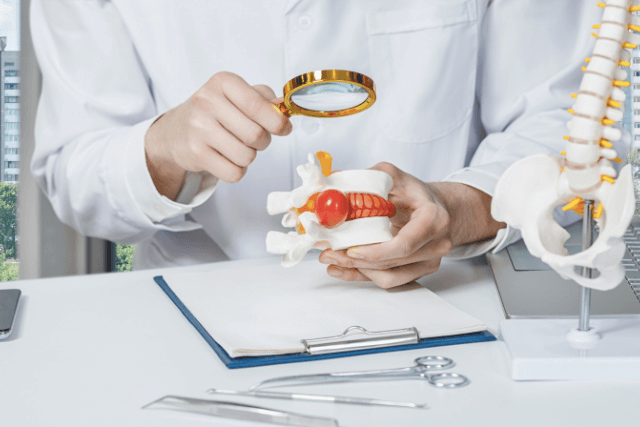A hiatal hernia happens when part of the stomach bulges through the diaphragm into the chest cavity. While this condition can lead to various symptoms, it can also be managed effectively with the right knowledge. This blog will walk you through the hiatal hernia symptoms, its causes, and the treatment options available. With the right approach, managing a hiatal hernia can become a manageable part of your health routine.
Let’s begin by exploring the basics of a hiatal hernia and how it affects your body.
What Is a Hiatal Hernia?
A hiatal hernia occurs when a portion of your stomach pushes upward through an opening in your diaphragm known as the “hiatus.” This opening allows the esophagus to connect to the stomach. In the case of a hiatal hernia, part of the stomach moves into the chest, therefore causing discomfort and various digestive issues.
There are two main types of hiatal hernia:
Sliding Hiatal Hernia: The stomach and the junction between the stomach and esophagus slide up into the chest. This is the most common type.
Paraesophageal Hiatal Hernia: This occurs when a part of the stomach pushes through the hiatus and sits next to the esophagus. It’s less common but can be more serious.
Now that you know what a hiatal hernia is, let’s look at the symptoms that may arise from this condition.
Symptoms of Hiatal Hernia
While some people may not notice any symptoms of a hiatal hernia, others experience discomfort. The symptoms may vary in severity, and they can sometimes overlap with other conditions. Common symptoms include:
1. Heartburn
Heartburn is one of the most common symptoms associated with a hiatal hernia. This occurs when stomach acid travels into the esophagus, causing a burning sensation in your chest or throat. The symptoms worsen if you lie down soon after eating.
2. Regurgitation
Regurgitation is the backward flow of food or liquid into the mouth. This occurs because the hernia disrupts the normal function of the lower esophageal sphincter (LES), which is responsible for preventing stomach contents from flowing back up.
3. Chest Pain
Chest pain caused by a hiatal hernia can feel similar to the pain associated with heart disease. It can be sharp and uncomfortable. Therefore, it’s important to differentiate this pain from potential heart issues by seeking medical advice.
4. Difficulty Swallowing
As the hiatal hernia increases in size, swallowing can become difficult. The hernia can block the normal movement of food from the esophagus to the stomach, thus causing food to feel stuck in the throat.
5. Bloating and Belching
Excessive bloating and frequent burping are common in people with hiatal hernias. This happens because the stomach cannot properly release gas due to the hernia. The trapped air leads to a feeling of fullness or bloating.
6. Shortness of Breath
Shortness of breath may occur in severe cases, especially with a paraesophageal hernia. This happens when the stomach presses on the diaphragm and makes breathing difficult.
Although these symptoms are often linked to a hiatal hernia, it is essential to seek a healthcare professional’s advice to confirm the diagnosis.
Causes of Hiatal Hernia
Understanding the causes can help you take steps to reduce your risk. Several factors contribute to the development including:
1. Increased Abdominal Pressure
Certain activities or conditions increase pressure in the abdomen, which can push the stomach through the diaphragm. Chronic coughing, straining during bowel movements, and heavy lifting are common contributors to this added pressure.
2. Aging
As people age, their diaphragm weakens. This weakening can lead to a larger hiatus, making it easier for the stomach to slide into the chest. As a result, hiatal hernias are more common in older adults.
3. Injury or Trauma
Injury to the abdomen or diaphragm can cause the stomach to move upward, thus resulting in a hiatal hernia. This can happen due to physical trauma or surgical procedures that affect the diaphragm.
4. Genetics
Genetics may play a role in the development of a hiatal hernia. Some individuals are more likely to develop this condition due to family history.
5. Obesity
Being overweight or obese increases the risk of a hiatal hernia. Extra abdominal fat puts pressure on the stomach, thus pushing it upward. Also, Losing weight can help alleviate this pressure and prevent hernia formation.
6. Pregnancy
Pregnancy can also increase the likelihood of a hiatal hernia, as the growing uterus puts additional pressure on the stomach. This is often temporary and resolves after childbirth.
Treatment Options for Hiatal Hernia
The treatment for this condition depends on the severity of the symptoms. In many cases, lifestyle changes and medications are sufficient. However, more severe cases may require surgical intervention. Let’s take a look at some of the common treatment options.
1. Lifestyle Changes
For mild cases, lifestyle changes can go a long way in managing symptoms. These changes focus on reducing pressure on the stomach and improving digestion:
- Smaller, More Frequent Meals: Eating smaller meals throughout the day can reduce stomach pressure. Also avoid large meals that cause discomfort.
- Avoid Lying Down After Eating: It’s important to stay upright for at least two to three hours after eating. This gives your body time to digest the food and prevents acid reflux.
- Elevate the Head of the Bed: Raise the head of your bed by six to eight inches to help prevent acid reflux during sleep.
- Avoid Trigger Foods: Certain foods, such as spicy foods, citrus fruits, chocolate, and fatty foods, can aggravate heartburn and acid reflux. Eliminate these from your diet to reduce symptoms.
2. Medications
For many individuals, medications can help alleviate the symptoms of a hiatal hernia. These include:
- Antacids: These neutralize stomach acid and provide quick relief from heartburn.
- H2-receptor Antagonists: These drugs reduce the amount of stomach acid produced, which helps prevent acid reflux.
- Proton Pump Inhibitors (PPIs): These medications block acid production and are often prescribed for severe acid reflux caused by a hiatal hernia.
3. Surgery
In rare cases, when lifestyle changes and medications don’t provide relief, surgery may be required. The two most common surgical options are:
-
Laparoscopic Nissen Fundoplication:
This surgery involves wrapping the top of the stomach around the lower esophagus to prevent acid reflux.
-
Hernia Repair Surgery:
The surgeon will return the stomach to its proper position and repair the hernia.
Surgery is typically considered for those with large hiatal hernias, or for those experiencing severe and persistent symptoms despite other treatments.
Conclusion
A hiatal hernia is a manageable condition that affects many people, but the symptoms can be uncomfortable. With the right treatment, you can reduce or eliminate the symptoms and improve your quality of life. Lifestyle changes, medications, and, in some cases, surgery can all help in managing this condition effectively.
If you experience symptoms like heartburn, regurgitation, or chest pain, it’s important to see a healthcare provider. They can provide a proper diagnosis and recommend the most effective treatment options.
By taking the right steps, you can manage your hiatal hernia and prevent complications. Make sure to follow your doctor’s advice and make the necessary lifestyle changes to ensure long-term relief.



